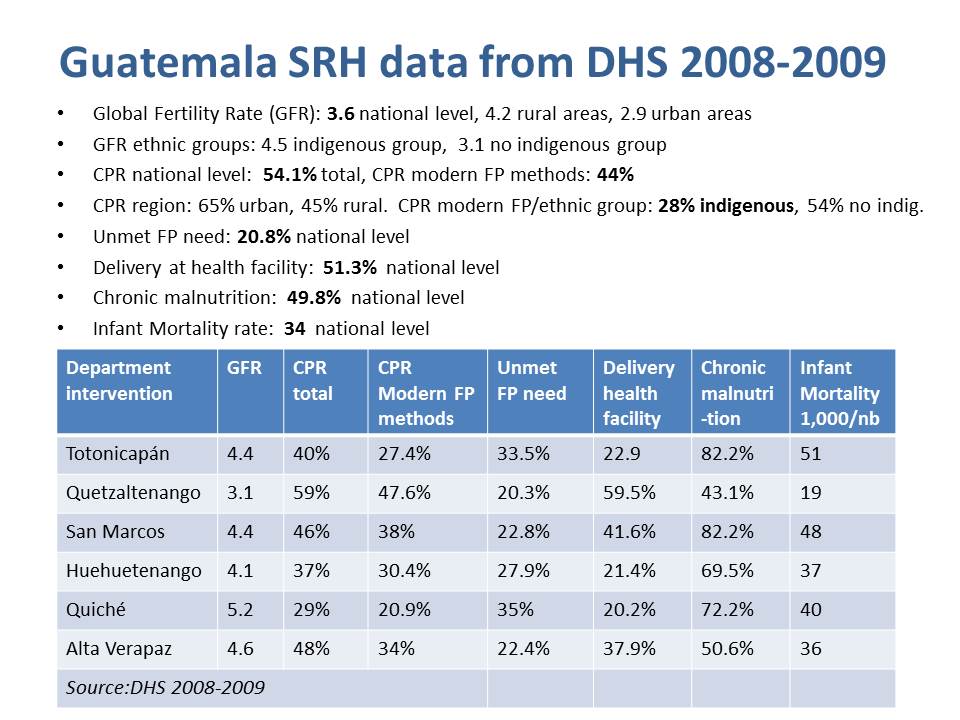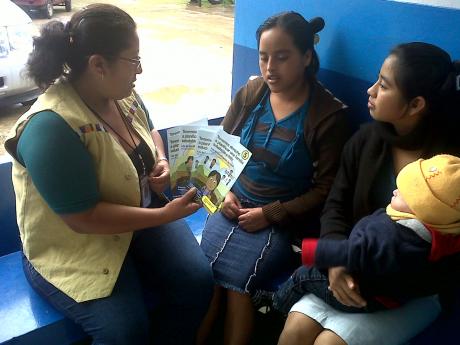Indigenous Guatemalans have faced a multitude of barriers to access and use of family planning services, as evidenced by the 2008 USAID Health Policy Initiative study. Family planning activities in Guatemala are founded upon the 2005 Ley de Acceso Universal y Equitativo de Servicios de Planificación Familiar, a controversial family planning law which was not enacted until 2009 after a four-year legal battle between opposing institutions.
The law approaches family planning as a human rights issue and includes these provisions:
- Health providers offer modern methods of family planning
- Health providers have the capacity to offer high quality family planning services based on medical criteria
- Family planning users, especially those living in rural areas, receive comprehensive consultation and are able to select the best family planning method for their specific situation
- Governmental organizations collaborate with the private sector and non-governmental organizations (NGOs) on mass media campaigns to reach the population with culturally sensitive information on traditional and modern methods of family planning, their advantages and disadvantages, and where to find them
- The law be applied at the national level in all public and private schools and health institutions, including the social security and NGOs.
While the Guatemalan family planning law was a historic advancement towards empowering all Guatemalans to access and use of family planning, few patients or providers knew the details of the law or their legal rights around family planning, thus preventing the law from becoming a transformative and empowering avenue to family planning for Guatemalans as intended.
Given the conclusions drawn from the Barriers to Access study, the low use of family planning reported in the DHS Sexual and Reprodctive Health Survey of 2008-2009 (see chart below), and the weak dissemination of the family planning law, PASMO* (Organización Panamericana de Mercadeo Social – Pan American Social Marketing Organization) developed strategies to create awareness of and demand for modern methods of family planning among both users and providers using a combination of interpersonal communication (IPC) techniques, mass media, entertainment education, and provider behavior change communication (PBCC).
As a key strategic component of the PlanFam project, PASMO also launched a campaign in 2012 to increase knowledge among the target populations about Guatemala’s family planning law in order to empower men and women to defend their rights and to raise awareness among providers so as to comply with their obligations around family planning and thus increase access to modern methods of contraception.
The Health COMpass is pleased to present the story of this important campaign’s development, implementation, and evaluation.

Special thank you: To Samantha Kerr of PSI who made invaluable contributions to this Spotlight!
*PASMO has a local presence in every Central American country and forms part of the global network of Population Services International (PSI).
Timeline
Inquire
The 2008 USAID Health Policy Initiative Study uncovered six key barriers to access for indigenous Guatemalans including:
- Bias of providers towards indigenous women
- Unsuitable conditions where family planning services are provided
- Lack of appropriate information, educational materials, and counseling for indigenous populations
- Limited integration of community-based providers in the community
- Beliefs within the community regarding family planning and associated behavior
- Restricted social and familial environments limiting the autonomy of women
These barriers are also reflected in the 2008-2009 Demographic Health Survey (DHS) data showing a 28% contraceptive prevalence rate (CPR) among indigenous populations, compared to 54% among non-indigenous populations.
The decision to focus an SBCC campaign on the family planning law was undertaken as a result of the USAID Barriers to Access study. Without knowledge of the law, family planning users were not positioned to defend their rights, and providers were not prepared to comply with their obligations under the law. SBCC interventions were needed so that these two groups could be convinced to work with each other to reach the shared goal of increasing access to modern methods of family planning.
The campaign to increase knowledge about the family law was implemented in conjunction with demand generation activities and provider behavior change communication activities.
“Beliefs (religion), social norms, social support, and gender-based violence influence people on FP decisions, especially women.”
Estudio sobre Planificación Familiar en la región del altiplano entre hombres y mujeres del área rural, Ronda 1
Design Strategy
The decision to focus on the family planning law fell within the greater program strategy to increase informed demand and access to high quality family planning services among Guatemalans living in the Western Highlands (see map). 
PASMO sought to frame family planning as a human right in order to both increase demand among users and to increase quality of services and client counseling among providers.
The goal of the family planning law communication campaign was to address young and adult women and men from rural areas in order to raise awareness of the right to family planning and of the National Family Planning Law.
Messaging about the family planning law was planned for distribution along the same communication channels as those used for demand generation for family planning, including community health workers, mass media (radio and print), educators, facilitators, and health practitioners employed through the Ministry of Health.
Communication materials were to be developed based on formative research and tested via focus groups with members of the target populations. The campaign was to be carried out in collaboration with USAID and local partners including civil society organizations and other local NGOs. Communication materials and messages were to be shared with these partners as well as with the Ministry of Health.
Create and Test
The creation and testing of materials was divided into two phases.
From August through September 2012 the audio visual materials were created and tested; from February-March 2013 the printed materials were created and tested. The production process took place from May through June 2013 to be ready to launch the campaign through mass media channels by July 2013. Materials were tested with focus groups to ensure acceptability and comprehension.
Campaign materials included:
- 5 radio spots (30 seconds each) in Spanish & 5 Mayan languages
- 1 video (10 minutes) in Spanish & 5 Mayan languages
- 1 poster, in Spanish
- 5 pamphlets in Spanish, 1 comic book in Spanish, & 1 flipchart in Spanish
Only audio and radio materials were translated into the five main Mayan languages spoken in the region of the project’s intervention. Printed materials were not translated as a very small percentage of the indigenous population reads Mayan languages.
“Low literacy rates among the audience reached by the project made it necessary to create materials using friendly images, and to adapt the text of the FP law into simple and short sentences to provide key messages to the audience.”
Haydée Lemus, Communication Specialist, USAID|PlanFam project
- Guatemala Family Planning Law Creative Brief
- Tenemos Derecho a Planificar una Familiar Saludable y Feliz Pamphlet #2
- Tenemos Derecho a Planificar una Familiar Saludable y Feliz Pamphlet #3
- Tenemos Derecho a Planificar una Familiar Saludable y Feliz Pamphlet #4
- Tenemos Derecho a Planificar una Familiar Saludable y Feliz Pamphlet #5
- Tenemos Derecho a Planificar una Familiar Saludable y Feliz Comic
- Family Planning and Law Campaign TV and Radio Spot #1
- Family Planning and Law Campaign TV and Radio Spot #2
- Family Planning and Law Campaign TV and Radio Spot #3
Mobilize and Monitor
The campaign was launched in July 2013 for a period of three months initially, and then a second phase in February 2014 for one additional month. It was broadcast on national and local radio, in Spanish and the five main Mayan languages spoken in the region.
Channels used to disseminate the campaign include:
- Mass media – radio and print; distributing pamphlets in health clinics
- Interpersonal communication – training of community health workers, educators, health providers about the FP law
- Entertainment education and community activities – health fairs, kiosks, puppets
- Community mobilization – meetings with local authorities

Distributing pamphlets in heath clinics.
Evaluate and Evolve
An AdTrac study was implemented to evaluate the campaign in May 2014. The study included both quantitative and qualitative approaches. The sample [n=384] included 188 men (49%) and 196 women (51%) between 18 – 49 years old living in the prioritized departments where USAID|PlanFam project activities are implemented. Sample size was defined with a confidence interval of 95% and was based on the total population of men and women in the selected municipalities using population projections for 2014 from The National Statistics Institute (INE).
The questionnaire was administered face-to-face and included mixed questions (open and closed). The study evaluated the recall of messages regarding the Guatemalan Family Planning Law and the channels through which those messages were received.
14.9% of participants sampled responded that they knew about the FP law. The main concepts recalled include:
- I have the right to plan my family – 31.9%
- Women are at risk when there are many pregnancies or not well spaced – 14.7%
- Women’s lives are at risk when pregnancy is unplanned (too young or too old) – 14.7%
Results demonstrated that within a short time frame, PASMO was able to significantly increase knowledge about the family planning law. Within a year, nearly 15% of the target population had some knowledge of the law from a baseline of 0% and was considered a major breakthrough by the Ministry of Health, partnering NGOs, and other key stakeholders.
Channels for exposure to the FP Law campaign (spontaneous recall):
- 49.4% were exposed to the campaign through a visit to a health center
- 15.7% were exposed through the radio
- 21.3% recalled the images of the campaign among a series of other health images shown. Among those, 18.5% indicated the campaign was about the family planning law, 43.5% about family planning, 13.9% about the right to plan the family, and 24.1% about having a healthy and happy family
Evaluation of materials (n=164):
- Radio: 34.8% were exposed to at least one spot. Of those, 60.3% listened to the spot on the radio, the rest through other channels (health fairs, kiosks, etc). 84.2% of people that listened to a spot recalled the key messages.
- Video: 16.5% were exposed to a video. Of those, 44.8% saw the video at the health service. A 92.6% recall the key messages of the video.
- Pamphlet: 32.3% were exposed to a pamphlet. Of those, 59.4% saw the pamphlet at the health service and 4.7% saw it with a community health worker from the PlanFam project. 71.7% recalled the key messages.
- Comic book: 16.5% were exposed to the comic book. Of those, 60 % saw the comic book at the health service and a 16.7% saw it at a school facility. 63% recalled the key messages.
- Poster: 73.2% were exposed to the poster. Of those, 72.5% saw the poster at a health service, 9.2% on the street, and 7% at a school facility. 80.8% recalled the key messages.
- Flipchart: Only 8.5% were exposed to the flipchart. Of those, 50% saw it at the health service, 11% saw it at a FP clinic, and 5.6% with a community health worker from the PlanFam project. 64% of those who saw it recalled the key messages.
Main conclusions:
- Posters were the most effective channel for key message recall (the human right to family planning).
- Radio was the second most effective channel to disseminate the key messages.
- Most of the people exposed to the campaign recall the key messages and refer to the human right to family planning.
- All persons exposed to different materials in different channels (100%) indicated they liked the materials, and what they liked the most was the message about family planning.
Planning for the Future
While the family planning law campaign has ended, materials will continue to be distributed through the end of the PlanFam project in September of 2015. Exposure will continue to be measured in future studies. To date, the project has no further funding for national or local radio. However, printed materials continue in circulation.
Banner Photo: A family planning user and a health promoter discuss contraceptive methods in El Quiché, Guatemala. © 2014 Haydee Lemus/PASMO PSI Guatemala, Courtesy of Photoshare. This photo was Photoshare Image of the Year (10th Annual 2014 Photoshare Photo Contest) & Best photo of the Family Planning and Reproductive Health category, (9th Annual 2013 Photoshare Photo Contest), organized by K4Health Project, Johns Hopkins’ Center for Communication Programs.
For more information about this campaign, contact Haydee Lemus, Communication Specialist, PASMO Guatemala, hlemus@pasmo-ca.org.
Date of Publication: April 20, 2022


